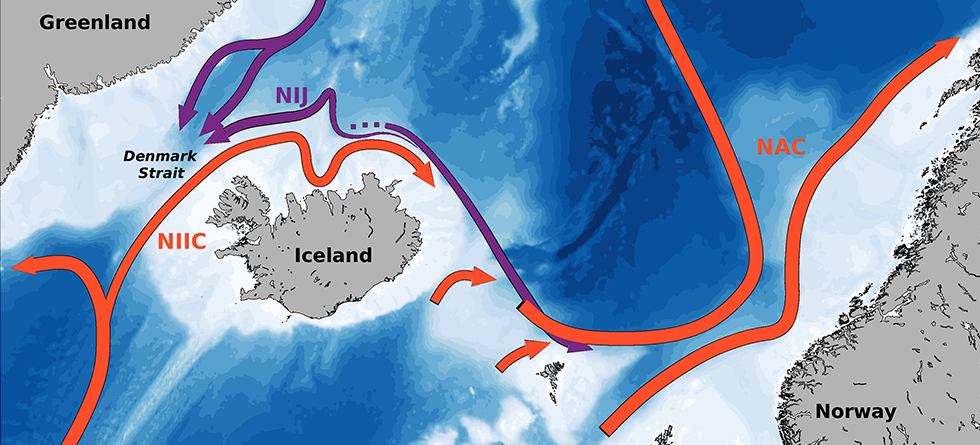Written by Stefanie Semper, Postdoc at the Bjerknes Centre and the Geophysical Institute at the University of Bergen.
The northward flow of warm, salty water west of Iceland gradually cools and freshens along its pathway following the shelf break and may be important for the dynamics of the dense flow returning southward, according to our new study.
The Gulf Stream brings warm, salty water northward, which is ultimately transformed into cold, dense water that returns southward at depth as part of the overturning circulation in the Atlantic Ocean.
The Norwegian Atlantic Current stretches like an arm of the Gulf Stream into the eastern Nordic Seas, which helps make the climate in Bergen warm and wet. Its Icelandic counterpart, the North Icelandic Irminger Current, enters the Nordic Seas west of Iceland and is important for Iceland’s climate and ecosystem. As this current is much weaker, it may be considered the Gulf Stream’s little finger.
Along with colleagues from the US and Iceland, we used a multitude of observational data to study the pathway and properties of the North Icelandic Irminger Current. We quantified how much water the current transports and how this water cools and freshens along its journey north of Iceland.
Our results show that the water in the current is mostly modified by mixing with surrounding waters, rather than through heat exchange with the atmosphere. Even in winter, heat loss to the cold overlying air is not the main mechanism for cooling the North Icelandic Irminger Current.
Contrary to recent model results, our observations demonstrate that locally transformed water is not dense enough to substantially supply an offshore deep current, the North Icelandic Jet, which returns dense water to the south through Denmark Strait as part of the overturning circulation.
Does this mean that the Gulf Stream’s little finger is not important for the large-scale circulation? Not quite so. While the direct transformation from warm and light to cold and dense water on the north Iceland shelf is not significant, we suggest that the surface and deep currents in this region may be dynamically linked.
We identified a hotspot of eddy kinetic energy northeast of Iceland, where turbulent eddies transport heat and salt offshore, from the shelf to the interior Iceland Sea. This is exactly where the deep current, the North Icelandic Jet, originates. In other words, some of the overturning in the Nordic Seas occurs at the Gulf Stream's fingertips.
Reference
Semper, S., Våge, K., Pickart, R.S., Jónsson, S., and Valdimarsson, H. (2022): Evolution and transformation of the North Icelandic Irminger Current along the north Iceland shelf, Journal of Geophysical Research: Oceans, 127, e2021JC017700. https://doi.org/10.1029/2021JC017700

